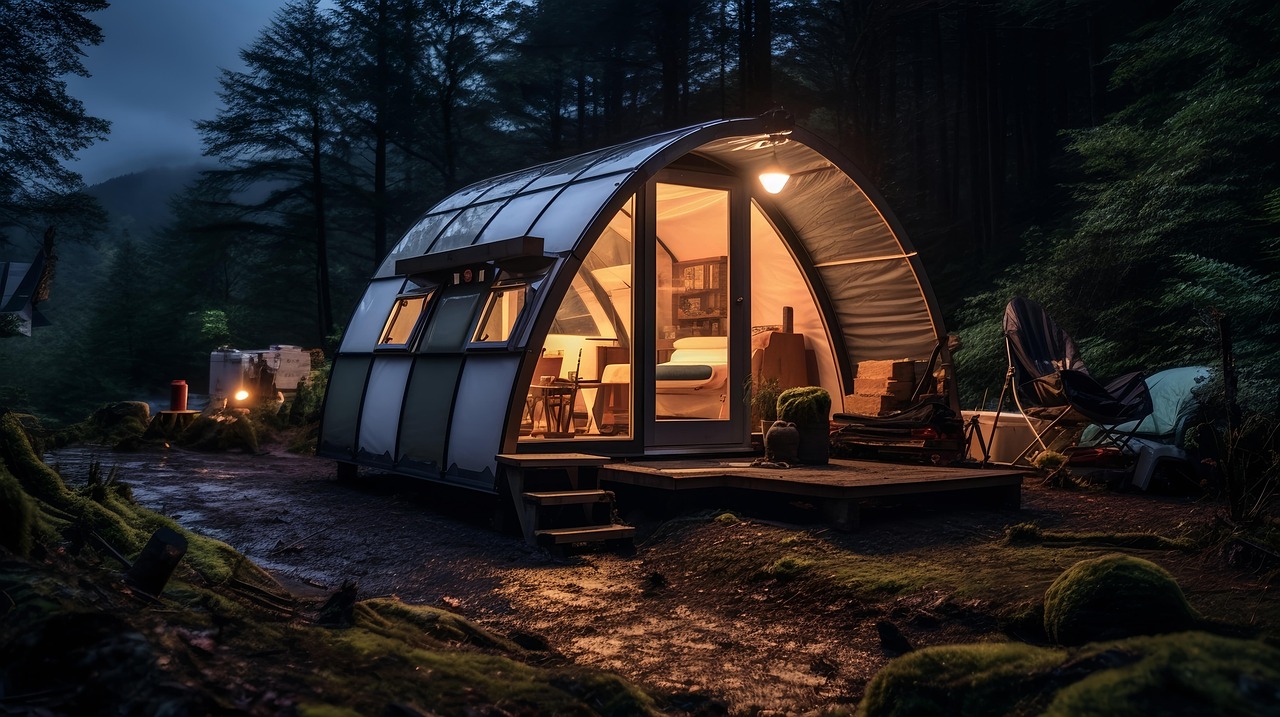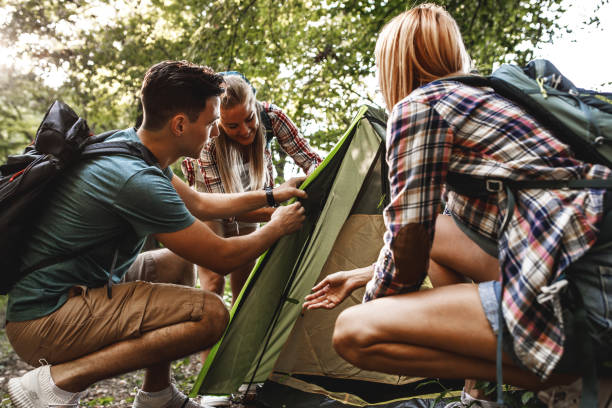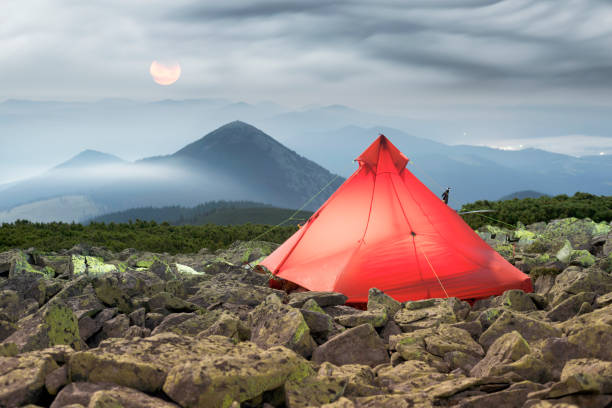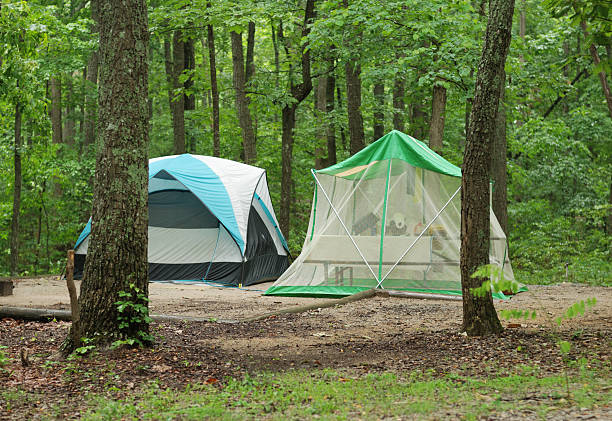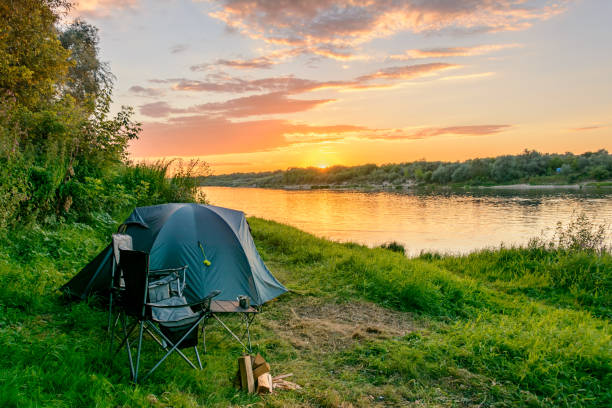If there’s one thing we’ve learned over years of camping trips with family and friends, it’s this: the right tent can make or break your adventure. When you’re camping with kids, pets, or even just a group of friends, space and durability aren’t just nice-to-haves—they’re absolute essentials. You need something that holds up in bad weather, gives everyone room to stretch out, and doesn’t turn into a puzzle every time you set it up. So, best camping tents for families, that’s what we are talking here!
We’ve tested dozens of family tents in the great outdoors—through unexpected rainstorms, windy nights, sunny days by the lake, and even a few “oops, we forgot the tarp” moments. What we’ve gathered is a list of the best family tent that are not just roomy, but impressively durable. These are tents that we’ve actually used out in the wild, not just glanced over in a store aisle. We pitched them, slept in them, spilled snacks inside them, and packed them up again—some more gracefully than others!
Table of Contents
- Ozark Trail Family Cabin Tent
- KAZOO 2/4 Person Camping Tent
- TETON Sports Mountain Ultra Tent
- The North Face Stormbreak Tent
- CORE Instant Cabin Tent
- Coleman Sundome 4/6 Person Tent
- Coleman Dome Camping Tent
- Our Verdict!
- How to Choose the Best Camping Tents for Families
- Size & Space (Interior Room and Layout)
- Weather Protection (Stay Dry and Safe)
- Ease of Setup (No One Likes a Fight with Tent Poles)
- What are the 4 types of tents?
- Are tents safe to sleep in?
- What is a 4 season tent?
7
Ozark Trail Family Cabin Tent
Best Style. We took the Ozark Trail Family Cabin Tent with us on a week-long trip to the Adirondacks, and let me tell you—this tent was like our little cabin in the woods. With a 14′ x 10′ footprint and 86 inches of headroom, it’s basically tall enough to walk around in without feeling hunched over. In fact, the only time we bent down was to walk through the door.
We fit a queen-sized air mattress for us, a pack-n-play in the corner for our toddler, and still had room left over for three bags of luggage and the family dog. It’s officially rated for 10 people, and while we weren’t maxed out, the space felt generous and well laid-out. The two-room divider gave us a little extra privacy—a big win when you’re camping with the in-laws!
Setup was surprisingly smooth. I actually got it pitched solo in about 20 minutes, even with a bit of wind. The 68D coated polyester fabric kept us dry through two solid nights of rain, and the factory-sealed seams and 6″ tub-style floor offered solid protection from ground moisture. The included rainfly did its job well, and we appreciated the gear loft and electrical cord access—little touches that made a big difference.
Honestly, for the price, you’d be hard-pressed to find this much tent. Sure, it’s not ultralight, but if you’re car camping with a family and want something that feels like a mini-lodge, this large family tent is a fantastic choice.
Feel free to check out this detailed review by Camping Guidance on YouTube!
Pros:
- Extra-large space with room divider and porch for group camping
- Multiple windows and mesh roof for excellent ventilation
- Electrical cord access for added convenience
Cons:
- Not ideal for windy or very rainy conditions due to lower weather resistance
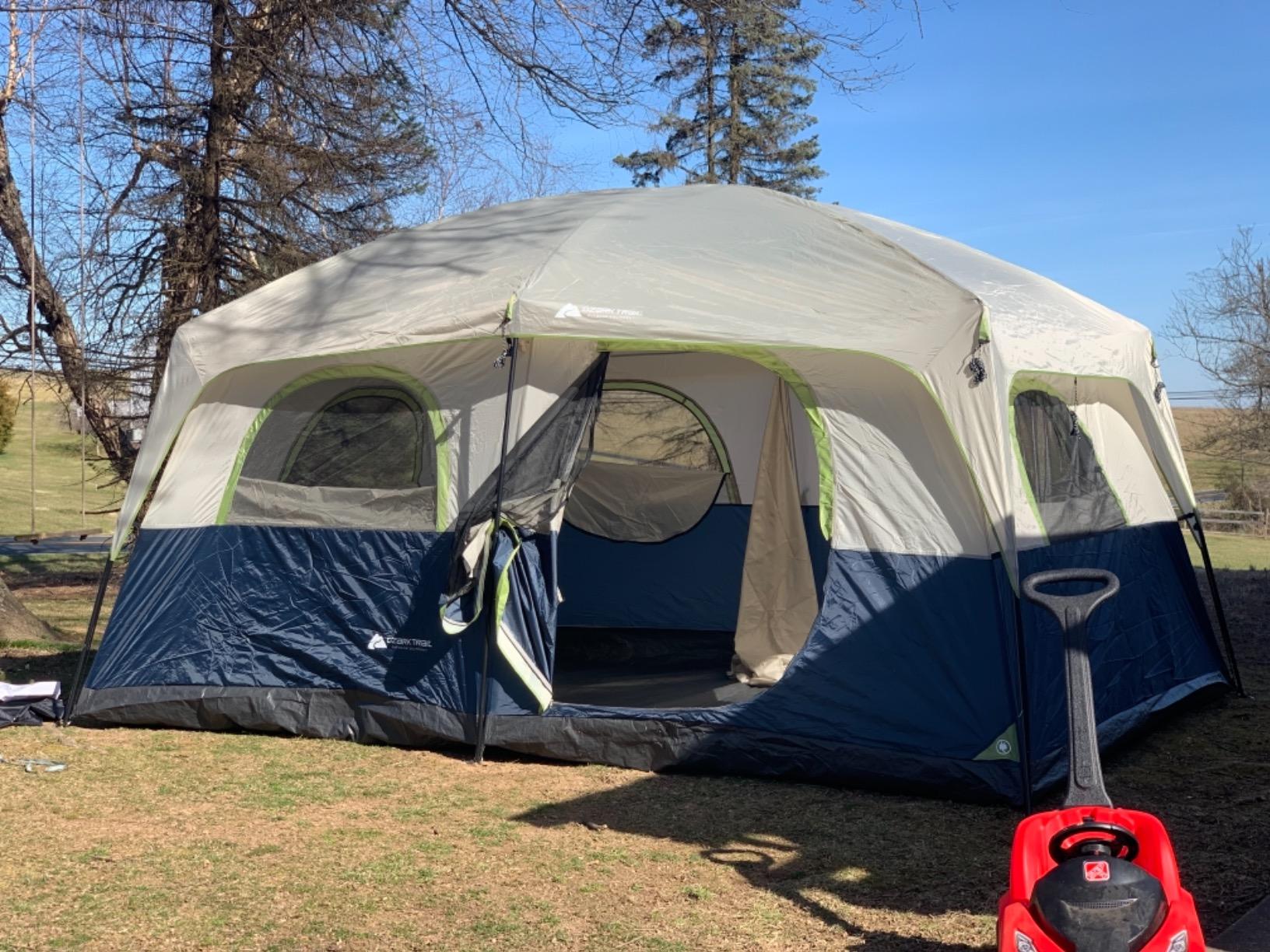
6
KAZOO 2/4 Person Camping Tent
We brought the KAZOO 2/4 Person Camping Tent on a three-day trip to Shenandoah National Park, and it hit a sweet spot between comfort and portability. Even with a couple of strong wind gusts the first night, the tent held its ground like a champ—no leaks, no bent poles, and no midnight scrambling to fix guy lines.
We loved how easy it was to set up—we had it up in under 10 minutes. It’s clear that KAZOO put a lot of thought into the design. With two doors and two windows, airflow wasn’t an issue even on humid nights. And the vestibule area? Perfect for keeping our muddy shoes and camp stove sheltered from the rain. That extra covered space really came in handy when it started drizzling one morning while we were making breakfast.
The 190T breathable polyester inner fabric combined with the 210T ripstop rainfly and floor kept us comfortable and dry. I’ll admit, the floor material feels a bit thin, so we used an extra tarp underneath just to be safe—but otherwise, the construction felt solid and reliable. At just 10.7 pounds packed, it was light enough for us to carry between sites without feeling like we were lugging around a small house.
We’ve now used this family camping tent for over 30 nights across various terrains, and it’s still going strong. For small families or couples with gear, it’s a well-balanced tent that delivers serious value.
Pros:
- 2-in-1 design with outer rainfly that doubles as a sun shelter
- Waterproof and UV-resistant materials
- Quick setup in about 3 minutes
Cons:
- Vestibule is on the smaller side, limiting gear storage space
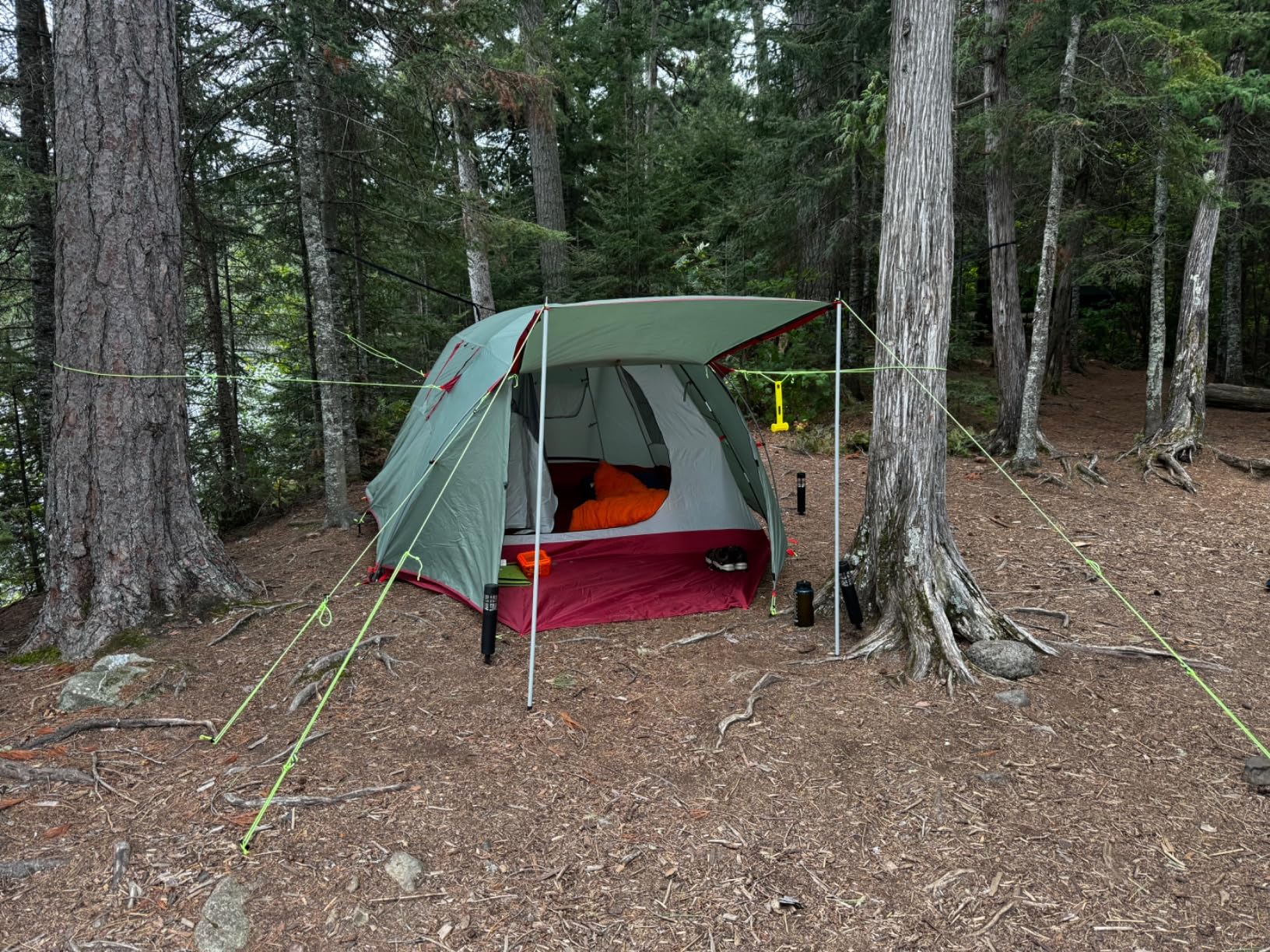
5
TETON Sports Mountain Ultra Tent
When we took the TETON Sports Mountain Ultra Tent on our annual fall camping trip out in the Smokies, we were hoping for clear skies and a good view of the stars—and this tent delivered both. Thanks to its full dome mesh top, we laid back on our sleeping bags one night and just stared up at the Milky Way like it was an IMAX screen. It was hands-down one of our favorite nights under the stars.
But this tent isn’t just about the view. The waterproof rainfly came in clutch when the weather turned on us two nights in, and we stayed bone dry thanks to the excellent 360-degree ventilation system. Even with everything sealed up tight, the airflow was so good that we never woke up feeling sticky or damp. The inner micro mesh and smart rainfly design kept everything well balanced.
Setting it up was a breeze—simple and intuitive, even for someone who doesn’t enjoy fiddling with tent poles after a long hike. Speaking of poles, we did end up swapping out the included tent stakes for sturdier ones, since the stock stakes struggled a bit in looser soil. Not a dealbreaker, just something to be aware of.
Being the best tent for family of 4, this isn’t the lightest, so we wouldn’t recommend it for deep backpacking trips. But for car camping, especially when the skies are clear and you want a “room with a view,” the TETON Mountain Ultra 4 is tough to beat.
See the official website of TETON to browse many more interesting options.
Pros:
- Full mesh top for starry-night views and great ventilation
- Full-coverage rainfly provides reliable weather protection
- Durable aluminum poles and reinforced seams
Cons:
- Vestibule space is modest compared to some competitors
4
The North Face Stormbreak Tent
Best Sturdiness. We used the The North Face Stormbreak Tent on a short hiking trip along the Appalachian Trail where space in our packs was limited, and this little powerhouse earned its keep. It’s not a family tent in the traditional sense—it fits two people comfortably—but for couples or a solo camper with gear, it’s more than enough.
Setup was lightning fast—we had it fully pitched and staked out in under five minutes. Everything about this tent screams quality. From the polyester fly and mesh to the polyurethane-coated materials, it held up beautifully through some nasty weather and even nastier bugs. Not a drop of water got in, and the mesh kept mosquitoes at bay without sacrificing ventilation.
What impressed us most was the durability and feel of the materials. After years of using budget tents where zippers snag and seams feel flimsy, the Stormbreak 2 felt like a major upgrade. It’s lightweight, perfect for weekend hikes, and the design is compact without being cramped.
We wouldn’t recommend it for a family of four, of course—but if you’re part of a group that splits into smaller tents, or you want a reliable shelter for short overnights, this pop up family tent is a winner through and through.
P.S. You may also be interested in our exclusive list of the best camping tents for all seasons. Do give it a read!
Pros:
- Two doors and two vestibules for easy access and storage
- Easy, intuitive setup with color-coded components
- High-quality materials and solid weatherproofing
Cons:
- A bit heavier and bulkier for backpacking compared to ultralight models
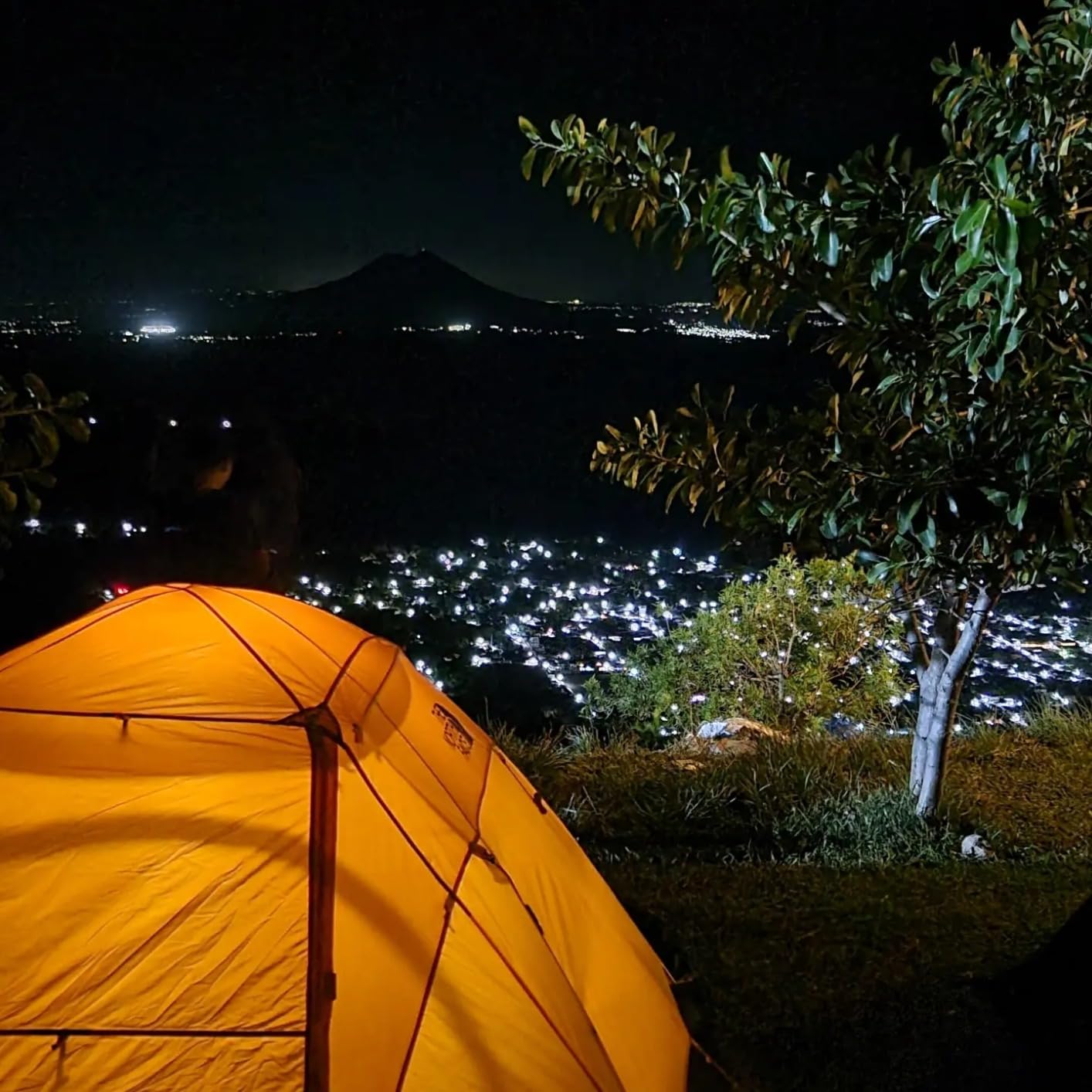
3
CORE Instant Cabin Tent
The CORE Instant Cabin Tent is where comfort meets convenience in the best way. This is the tent we used for a glamping-style trip to the Smokies with some friends, and it was hands-down one of the most comfortable camping experiences I’ve had.
Let’s start with the setup—true to its promise, it went up in about 60 seconds. The pre-attached poles just snap into place like magic. It took longer to roll out the sleeping bags than to pitch this tent. Sure, the rainfly took a few extra minutes to secure, but once it was up, the whole structure felt rock-solid.
This tent is huge. With 11 x 9 feet of floor space and a 6-foot center height, we easily fit two queen air mattresses, a dog bed, and a small table with room to spare. On a different trip, we fit one queen and two cots without feeling cramped. If you’re a car camper who likes to spread out, this is your tent.
Weather protection? This thing is a tank, best waterproof family tent. We camped through a massive storm—over 11 inches of rain in less than 24 hours. Water was lapping up around the bottom of the tent, but not a single drop got in. Even when the wind howled, it stood its ground like a champ. Between the H20 Block Technology, taped seams, and sturdy steel stakes, it’s built to hold strong in rough conditions.
Inside, it’s well thought out too. You get a gear loft and organizer pockets to keep essentials handy, and the adjustable ventilation system makes a big difference in managing condensation. Cool air comes in low, and warm air escapes through the mesh ceiling, which keeps things comfortable even when the temps dip at night. We camped in near-freezing weather once and woke up to a surprisingly toasty 50°F inside with zero condensation on the walls.
This tent is a little heavy for one person to haul far, but that’s the tradeoff for comfort and durability. If you’re setting up near your car and want a tent that feels like a cabin in the woods—spacious, secure, and downright cozy—the CORE Instant Cabin should be at the top of your list.
Pros:
- Instant 60-second setup with pre-attached poles
- H2O Block Technology keeps interior bone-dry—even in heavy rain
- Spacious interior fits two queen air mattresses with room to spare
Cons:
- Heavier and bulkier to transport due to size and materials
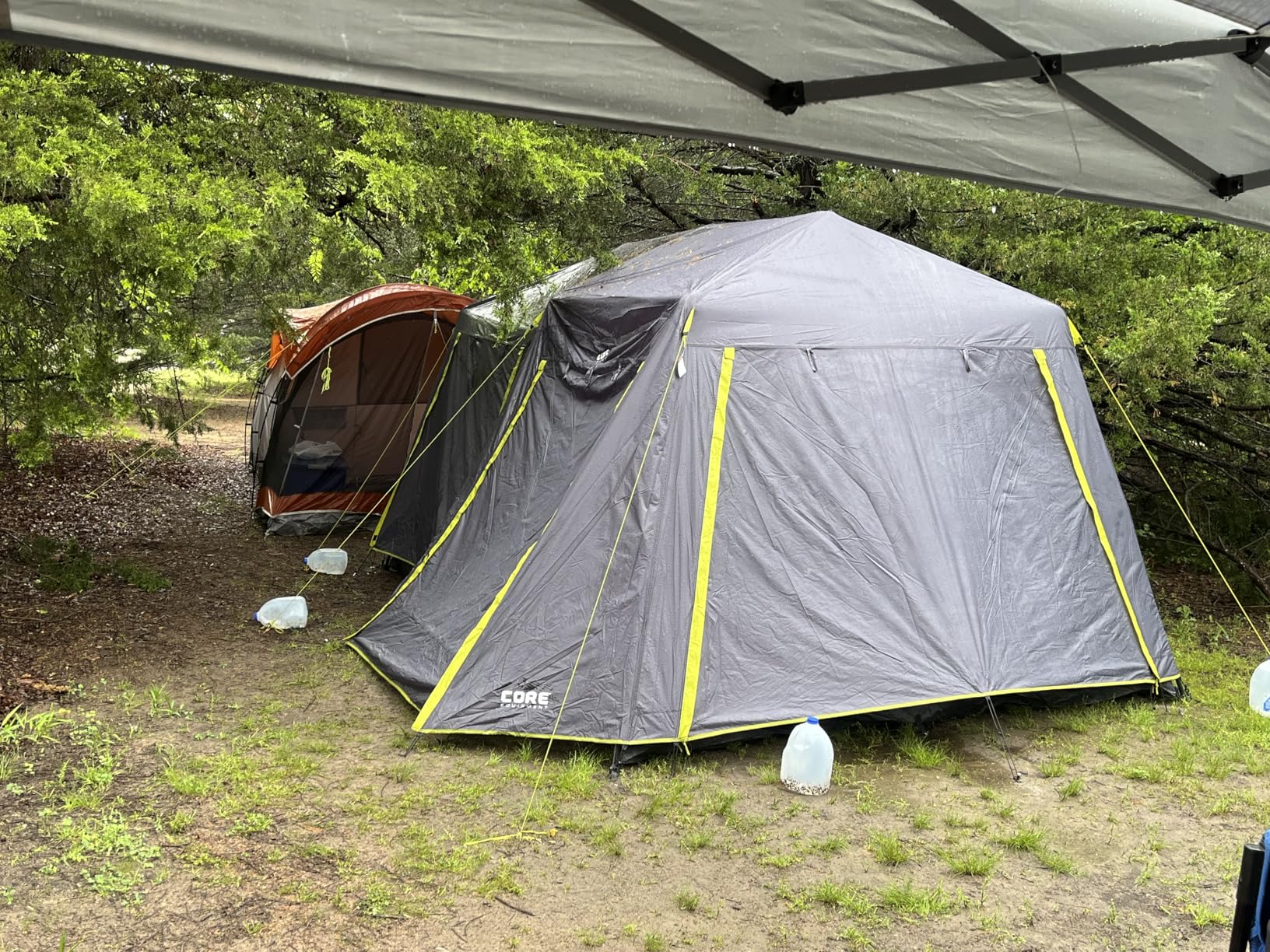
2
Coleman Sundome 4/6 Person Tent
Camping during music festivals, road trips, or just weekend getaways in the summer? Let me tell you, the Coleman Sundome 4/6 Person Tent with Dark Room Technology is an absolute game-changer for folks who value their shut-eye. I brought the 4-person version to a bluegrass festival in Colorado, and after the first morning sleeping past 9 a.m. without getting roasted alive or blinded by sunlight, I was sold.
That Dark Room tech really does block out about 90% of the sunlight—no more waking up at the crack of dawn feeling like you’re in a toaster oven. Plus, it actually stayed a few degrees cooler inside the tent. Combine that with the WeatherTec™ system, and you’ve got a tent that keeps you dry and lets you snooze in.
We got a decent storm that weekend and while some folks nearby were dealing with puddles inside their tents, we stayed dry. Pro tip from a seasoned camper we met: spray the seams with silicone spray before the season starts—it helps seal everything up tighter than a drum.
Setup was quick—snag-free pole sleeves are no joke—and it fit our queen-size airbed with a little wiggle room for our gear. There’s also an E-port for power access, which came in handy for charging our phones. And those Illumiline reflective guylines? Super helpful when you’re stumbling around in the dark after a long day and a few campfire drinks.
Only drawback? The 4’11” center height means you won’t be doing jumping jacks in there, but it’s cozy and efficient. If you’re a couple or solo camper and want blackout sleeping and weather protection in a compact, car-camping-friendly package, coming from extra large family camping tents, this one delivers big value.
Here’s the official listing for the product in case you need further information.
Pros:
- Dark Room Technology blocks 90% of sunlight—perfect for sleeping in
- The welded floors and inverted seams keep water out
- Quick and easy setup with snag-free pole sleeves
Cons:
- Limited standing room with lower center height.
1
Coleman Dome Camping Tent
Best Overall. If you’re looking for a reliable, roomy, and budget-friendly starter tent that doesn’t skimp on performance, the Coleman Dome Camping Tent is a solid bet. We took this one out on a family weekend trip up in the Adirondacks, and from setup to takedown, it was refreshingly straightforward. I had it up in about 10 minutes—less time than it took to get the kids out of the car.
What really stood out was the WeatherTec™ system. One night we got caught in a surprise downpour. I’ll admit, I was a little worried at first—but not a drop made it inside. The welded corners and inverted seams did their job, and the included rainfly added another layer of protection. We stayed bone dry. Even with wind gusts upwards of 30 mph, the tent stood its ground like a champ.
At 10 x 10 feet with a 6-foot center height, there was more than enough space for two queen airbeds and all our gear. I’m 6’1″, and I could easily stand up without crouching. Ventilation was solid thanks to large windows and a ground vent, which really helped keep the airflow going during the warmer part of the day.
One feature I loved: the E-port. We ran an extension cord for lights and a fan—glamping level unlocked. And those little storage pockets on the sides? Perfect for tossing flashlights, phones, and car keys so they don’t get lost in sleeping bag oblivion.
Bottom line: This isn’t a four-season mountain tent, but for fair-weather camping spring through fall, it’s a fantastic choice. Sturdy, well-ventilated, and roomy without being a pain to haul around or set up. A great intro tent for families or beginners who want reliability without blowing the budget.
Pros:
- Spacious 10×10 ft interior fits two queen airbeds comfortably
- Great ventilation with large windows and ground vents
- Fast 10-minute setup with continuous pole sleeves
Cons:
- Fiberglass poles may be less durable than aluminum in tough conditions
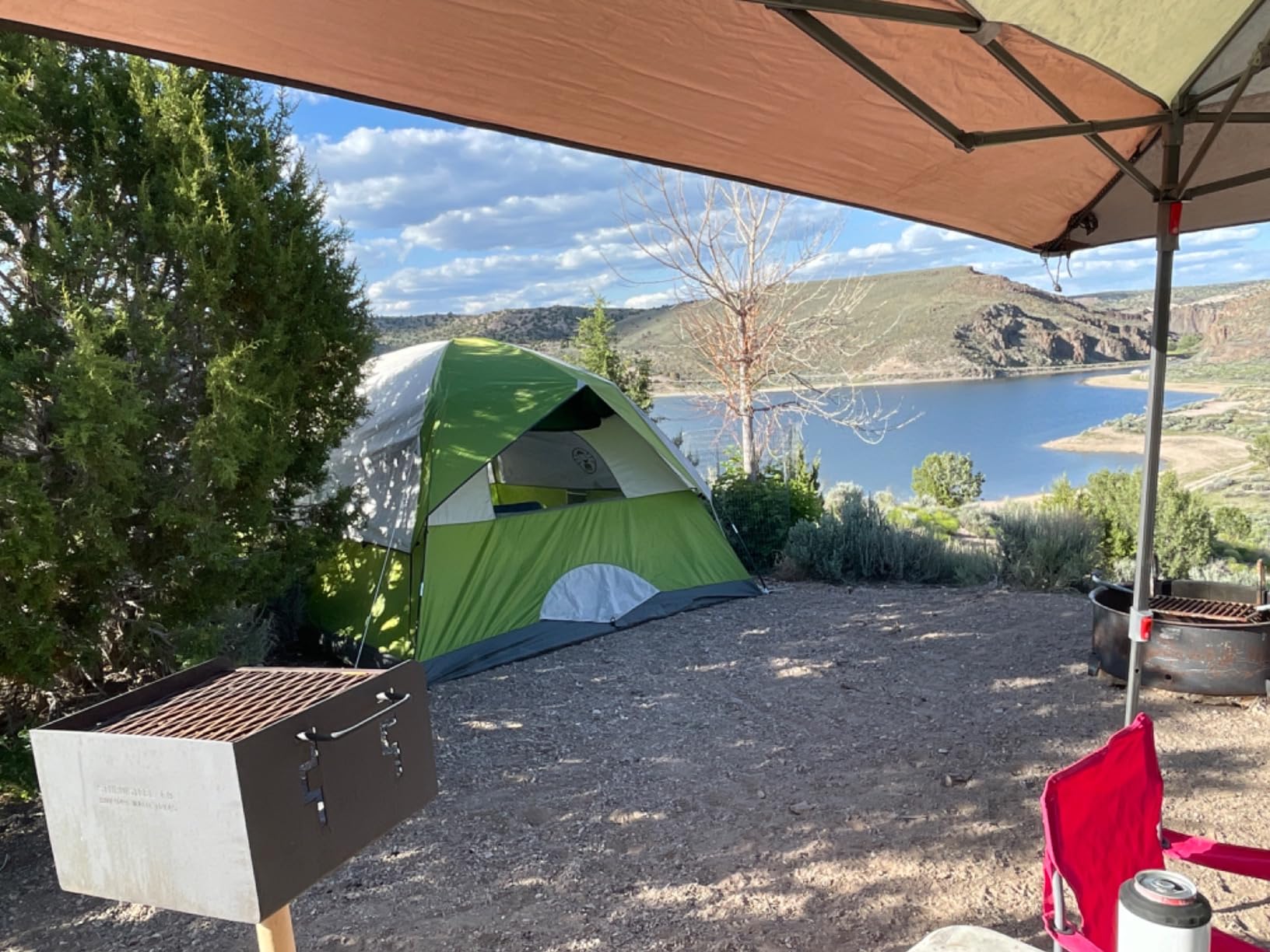
Our Verdict!
We chose the Coleman Dome Camping Tent as the Best Overall option from the above list of best camping tents for families given its exceptional performance and everybody we talked to had only good things to say about this one. So, it was actually a no-brainer as our no.1 choice. Having said that, there are other top options from the roundup that we set aside based on their amazing performance in one particular area. What are they? Let’s check out!
- Best Sturdiness: The North Face Stormbreak Tent
- Best Style: Ozark Trail Family Cabin Tent
You might also want to check out our roundup of the 7 Best Camping Tents for Beginners!
How to Choose the Best Camping Tents for Families
When it comes to family camping, comfort and convenience are the name of the game. The right tent can turn a weekend in the woods into an unforgettable experience for everyone. Here are three essential features we looked for when choosing the best family camping tents for this roundup:
1) Size & Space (Interior Room and Layout)
Families need elbow room—especially when you’re cramming in kids, gear, and maybe even the family dog.
What to look for:
- A tent that sleeps more people than you have (e.g., choose an 8-person tent for a family of 5 to allow gear space)
- Tall center height so adults can stand up inside
- Room to fit air mattresses or cots comfortably
- Some tents even have room dividers for a bit of privacy
Pro tip: Always subtract one or two from the manufacturer’s “person capacity” for a more realistic fit.
2) Weather Protection (Stay Dry and Safe)
Rain, wind, and morning dew don’t care if you’re on vacation. A solid tent keeps your family dry and protected no matter the forecast.
What to look for:
- A full-coverage rainfly that extends close to the ground
- Taped seams and bathtub-style floors to prevent leaks
- Wind-resistant poles and guylines for stability
- Look for tents rated for 3-season use if you’re camping spring through fall
Pro tip: Even waterproof tents benefit from spraying the seams with sealant at the start of each season.
3) Ease of Setup (No One Likes a Fight with Tent Poles)
Tired kids and frustrated parents don’t mix well. The faster the setup, the quicker you can get to the s’mores.
What to look for:
- Color-coded or pre-attached poles for fast setup
- Instant tents or pop-up frames if you’re camping frequently
- One-person setup capability (a lifesaver if you arrive early or solo)
Pro tip: Practice pitching the tent in your backyard before the trip—it can save you time and trouble at the campsite.
What are the 4 types of tents?
There are four main types of tents, each designed for different camping styles. Dome tents are the most common and popular for casual campers. They’re easy to set up and hold up well in wind, making them great for short trips or smaller groups. Cabin tents are ideal for families because of their tall, straight walls and roomy interiors, often allowing you to stand up fully inside. Tunnel tents are more elongated in shape and offer multiple rooms, which makes them a solid choice for larger groups, though they can be trickier to set up. Lastly, pop-up or instant tents are the easiest to pitch, thanks to their pre-attached poles.
Are tents safe to sleep in?
Yes, tents are generally safe to sleep in, especially when used properly and in suitable camping conditions. They provide protection from insects, rain, and moderate wind, and most are designed with breathable materials to reduce condensation inside. As long as you set up your tent on level ground, away from potential hazards like falling branches or rising water, and follow basic campsite safety—like keeping food stored away from your sleeping area to avoid attracting wildlife—tents are a perfectly safe and comfortable option for sleeping outdoors.
What is a 4 season tent?
A 4-season tent is designed to withstand harsh weather conditions all year round, including heavy snow, strong winds, and cold temperatures. Unlike 3-season tents, which are best for spring, summer, and fall, a 4-season tent has stronger poles, more durable fabric, and a shape that helps shed snow. It provides better insulation and protection, making it ideal for winter camping or high-altitude adventures. However, it can be heavier and less ventilated, which might not be comfortable in hot weather.
